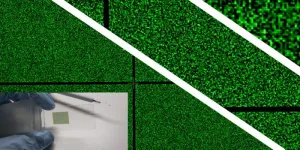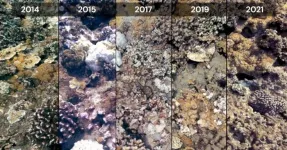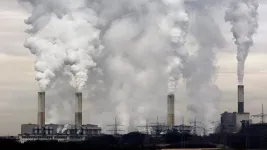(Press-News.org) An international research team led by the University of Vienna has succeeded in developing a new version of RNA building blocks with higher chemical reactivity and photosensitivity. This can significantly reduce the production time of RNA chips used in biotechnological and medical research. The chemical synthesis of these chips is now twice as fast and seven times more efficient. The results of the research were recently published in the prestigious journal Science Advances.
The emergence and approval of RNA-based medical products, such as mRNA vaccines during the COVID-19 pandemic, has brought the RNA molecule into the public eye. RNA (ribonucleic acid) is an information-carrying polymer – a chemical compound made up of similar subunits – but with far greater structural and functional diversity than DNA. About 40 years ago, a method was developed for the chemical synthesis of DNA and RNA, in which any sequence can be assembled from DNA or RNA building blocks using phosphoramidite chemistry. The assembly of a nucleic acid chain is carried out step by step using these special chemical building blocks (phosphoramidites). Each building block carries chemical 'protecting groups' that prevent unwanted reactions and ensure the formation of a natural link in the nucleic acid chain.
Overcoming challenges
This chemical method is also used in the production of microchips (microarrays), where millions of unique sequences can be synthesised and analysed simultaneously on a solid surface the size of a fingernail. While DNA microarrays are already widely used, adapting the technology to RNA microarrays has proved difficult due to the lower stability of RNA.
In 2018, the University of Vienna demonstrated how high-density RNA chips can be produced through photolithography: by precisely positioning a beam of light, areas on the surface can be prepared for the attachment of the next building block through a photochemical reaction. Although this first report was a world first and remains unrivalled, the method suffered from long production times, low yields and poor stability. This approach has now been greatly improved.
Development of a new generation of RNA building blocks
A team from the Institute of Inorganic Chemistry at the University of Vienna, in collaboration with the Max Mousseron Institute for Biomolecules at the University of Montpellier (France), has now developed a new version of RNA building blocks with higher chemical reactivity and photosensitivity. This advance significantly reduces the production time of RNA chips, making synthesis twice as fast and seven times more efficient. The innovative RNA chips can be used to screen millions of candidate RNAs for valuable sequences for a wide range of applications.
“Making RNA microarrays containing functional RNA molecules was simply out of reach with our earlier setup, but it is now a reality with this improved process using the propionyloxymethyl (PrOM) protecting group”, says Jory Lietard, Assistant Professor at the Institute of Inorganic Chemistry.
As a direct application of these improved RNA chips, the publication features a study of RNA aptamers, small oligonucleotides that specifically bind to a target molecule. Two “light-up” aptamers that produce fluorescence upon binding to a dye were chosen and thousands of variants of these aptamers were synthesized on the chip. A single binding experiment is sufficient to obtain data on all variants simultaneously, which opens the way for the identification of improved aptamers with better diagnostic properties.
“High-quality RNA chips could be especially valuable in the rapidly growing field of non-invasive molecular diagnostics. New and improved RNA aptamers are critically sought after, such as those that can track hormone levels in real-time or monitor other biological markers directly from sweat or saliva,” says Tadija Kekić, PhD candidate in the group of Jory Lietard.
This work was financially supported by a joint grant of the Agence Nationale pour la Recherche/Austrian Science Fund (FWF International Program I4923).
END
The next generation of RNA chips
Research team achieves breakthrough: chemical synthesis of high-density RNA microarrays now faster and more efficient
2024-07-31
ELSE PRESS RELEASES FROM THIS DATE:
3D models provide unprecedented look at corals’ response to bleaching events
2024-07-31
In a new study, marine biologists from Scripps Institution of Oceanography at UC San Diego and Arizona State University are providing a first-of-its-kind glimpse into coral “bleaching” responses to stress, using imaging technology to pinpoint coral survival rates following multiple bleaching events off the island of Maui. Their findings were published July 31 in the journal PLOS ONE.
Using a time series of coral reef 3D models from Maui, a team of researchers led by Scripps Oceanography’s Smith Lab tracked the bleaching response of 1,832 coral colonies from 2014 to ...
Study finds White Western women have lower body appreciation and greater media pressure to look thin
2024-07-31
White Western women have lower body appreciation and experience greater pressure from the media to be thin compared to Black Nigerian and Chinese women across all ages, according to new research.
The study, carried out by psychologists at Durham University (UK), and published in PLOS ONE, explored the impacts of age and sociocultural pressures on body appreciation (feelings of positivity and pride about one’s body) amongst White Western, Black Nigerian and Chinese women.
Whilst all three groups had relatively stable body appreciation across ages, there were significant cultural differences.
White ...
Underwater mapping reveals new insights into melting of Antarctica's ice shelves
2024-07-31
Clues to future sea level rise have been revealed by the first detailed maps of the underside of a floating ice shelf in Antarctica.
An international research team - including scientists from the University of East Anglia (UEA) - deployed an unmanned submersible beneath the Dotson Ice Shelf in West Antarctica.
The underwater vehicle, ‘Ran’, was programmed to dive into the cavity of the 350metre-thick ice shelf and scan the ice above it with an advanced sonar. Over 27 days, the submarine travelled more than 1000 kilometres back and forth under the shelf, reaching 17 kilometres into the cavity.
An ice shelf is a mass of glacial ice, fed from land by tributary glaciers, that ...
AI creates cardiology reports for patients
2024-07-31
An artificial intelligence program created explanations of heart test results that were in most cases accurate, relevant, and easy to understand by patients, a new study finds.
The study addressed the echocardiogram (echo), which uses sound waves to create pictures of blood flowing through the heart’s chambers and valves. Echo reports include machine-generated numerical measures of function, as well as comments from the interpreting cardiologist on the heart’s size, the pressure in its vessels, and tissue thickness, which can signal the presence of disease. In the form typically generated by doctors, the reports are difficult for ...
Nasal COVID-19 vaccine halts transmission
2024-07-31
The lightning-fast development of COVID-19 vaccines just months after the virus appeared was a triumph of modern science and saved millions of lives. But for all the good they did in reducing illnesses and deaths, the shots were unable to end the pandemic because of one notable weakness: They couldn’t stop the spread of the virus.
A new study by researchers at Washington University School of Medicine in St. Louis indicates that next-generation vaccines that target the virus’s points of entry — the nose and mouth — may be able to do what traditional shots cannot: contain the spread of respiratory infections and prevent transmission. ...
Downwind states face disproportionate burden of air pollution
2024-07-31
A recent Supreme Court decision to block a federal rule curbing interstate air pollution further complicates efforts to reduce emissions and adds to an already disproportionate burden on “downwind” states, according to researchers at the University of Notre Dame.
“Toxic air pollution is really not as well known by the general public as you would hope, given its impact on human health,” said Paola Crippa, assistant professor in the Department of Civil and Environmental Engineering and Earth Sciences. ...
Barriers designed to prevent saltwater intrusion may worsen inland flooding
2024-07-31
As Earth continues to warm, sea levels have risen at an accelerating rate – from 1.4 millimeters a year to 3.6 millimeters a year between 2000 and 2015. Flooding will inevitably worsen, particularly in low-lying coastal regions, where more than a billion people are estimated to live. Solutions are needed to protect homes, property and groundwater from flooding and the intrusion of saltwater.
Seawalls and similar infrastructure are obvious options to protect against flooding. In fact, cities such as New York and San Franciso have already thrashed out potential plans with the Army Corps of Engineers that will heavily rely ...
Vaping and smoking together increases lung cancer risk fourfold
2024-07-31
COLUMBUS, Ohio – People who both vape and smoke are four times more likely to develop lung cancer than people who just smoke, according to new study published by The Ohio State University Comprehensive Cancer Center – Arthur G. James Cancer Hospital and Richard J. Solove Research Institute (OSUCCC – James) and College of Public Health. These findings were consistent across gender and race.
This is the first study to provide evidence that smoking in combination with vaping increases the risk for cancer compared to smoking alone. Researchers ...
Scientists discover unexpected behavior in dimers of CO₂ molecules after ionization
2024-07-31
A team of international scientists has unveiled a surprising discovery in molecular physics, revealing unexpected symmetry-breaking dynamics in ionized carbon dioxide dimers. Published in Nature Communications, the study provides new insights into the structural changes that occur when these molecular clusters are exposed to extreme ultraviolet (EUV) radiation.
An international team of scientists, led by Profs. Daniel Strasser and Roi Baer from The Hebrew University of Jerusalem, has made an important discovery in molecular physics, revealing unexpected symmetry-breaking dynamics in ionized carbon dioxide dimers. Published in Nature Communications, ...
Cracking the carb code: Researchers create new glycemic index database to improve dietary awareness
2024-07-31
Karen Della Corte, BYU nutrition and dietetics professor, recently authored a new study, published in The American Journal of Clinical Nutrition, that developed a national glycemic index (GI) and glycemic load (GL) database to offer insights into the evolving quality of carbohydrates consumed in the United States, something that hadn’t been done previously.
The GI is a scale used by public health researchers to categorize the quality of the carbohydrates. High-GI foods like white flour and sugar cereals cause a “sugar rush” that can negatively impact metabolic health. ...
LAST 30 PRESS RELEASES:
Interaction of climate change and human activity and its impact on plant diversity in Qinghai-Tibet plateau
From addressing uncertainty to national strategy: an interpretation of Professor Lim Siong Guan’s views
Clinical trials on AI language model use in digestive healthcare
Scientists improve robotic visual–inertial trajectory localization accuracy using cross-modal interaction and selection techniques
Correlation between cancer cachexia and immune-related adverse events in HCC
Human adipose tissue: a new source for functional organoids
Metro lines double as freight highways during off-peak hours, Beijing study shows
Biomedical functions and applications of nanomaterials in tumor diagnosis and treatment: perspectives from ophthalmic oncology
3D imaging unveils how passivation improves perovskite solar cell performance
Enriching framework Al sites in 8-membered rings of Cu-SSZ-39 zeolite to enhance low-temperature ammonia selective catalytic reduction performance
AI-powered RNA drug development: a new frontier in therapeutics
Decoupling the HOR enhancement on PtRu: Dynamically matching interfacial water to reaction coordinates
Sulfur isn’t poisonous when it synergistically acts with phosphine in olefins hydroformylation
URI researchers uncover molecular mechanisms behind speciation in corals
Chitin based carbon aerogel offers a cleaner way to store thermal energy
Tracing hidden sources of nitrate pollution in rapidly changing rural urban landscapes
Viruses on plastic pollution may quietly accelerate the spread of antibiotic resistance
Three UH Rainbow Babies & Children’s faculty elected to prestigious American Pediatric Society
Tunnel resilience models unveiled to aid post-earthquake recovery
Satellite communication systems: the future of 5G/6G connectivity
Space computing power networks: a new frontier for satellite technologies
Experiments advance potential of protein that makes hydrogen sulfide as a therapeutic target for Alzheimer’s disease
Examining private equity’s role in fertility care
Current Molecular Pharmacology achieves a landmark: real-time CiteScore advances to 7.2
Skeletal muscle epigenetic clocks developed using postmortem tissue from an Asian population
Estimating unemployment rates with social media data
Climate policies can backfire by eroding “green” values, study finds
Too much screen time too soon? A*STAR study links infant screen exposure to brain changes and teen anxiety
Global psychiatry mourns Professor Dan Stein, visionary who transformed mental health science across Africa and beyond
KIST develops eco-friendly palladium recovery technology to safeguard resource security
[Press-News.org] The next generation of RNA chipsResearch team achieves breakthrough: chemical synthesis of high-density RNA microarrays now faster and more efficient




